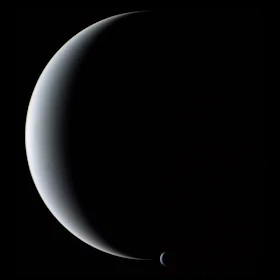Φωτογραφία που ελήφθη από το Voyager 2 το 1989: Ο πλανήτης Ποσειδώνας και ένας από τους δορυφόρους του, ο Τρίτωνας, και οι δυο σε φάση ημισελήνου. Gliding silently through the outer Solar System, the Voyager 2 spacecraft camera captured Neptune and Triton together in crescent phase in 1989. The elegant picture of the gas giant planet and its cloudy moon was taken from behind just after closest approach. It could not have been taken from Earth because Neptune never shows a crescent phase to sunward Earth. The unusual vantage point also robs Neptune of its familiar blue hue, as sunlight seen from here is scattered forward, and so is reddened like the setting Sun. Neptune is smaller but more massive than Uranus, has several dark rings, and emits more light than it receives from the Sun. Image Credit: Voyager 2, NASA
Ο Ποσειδώνας είναι ο όγδοος, κατά σειρά απόστασης από τον ήλιο, πλανήτης του Ηλιακού Συστήματος. Δεν είναι ορατός με γυμνό μάτι, ενώ αν παρατηρηθεί με ισχυρό τηλεσκόπιο μοιάζει με πράσινο δίσκο. O Ποσειδώνας ήταν ο πρώτος πλανήτης που ανακαλύφθηκε θεωρητικά το 1843, πριν παρατηρηθεί με τηλεσκόπιο, λόγω των βαρυτικών αλληλεπιδράσεών του με τον πλανήτη Ουρανό.
Voyager 2 acquired the images for this high-resolution mosaic of Triton on August 25, 1989. The south pole is at the right; several of Triton's famous south polar geysers are visible. Toward the equator at right, Triton is covered with a strange "cantaloupe terrain". Image Credit: NASA / JPL / Ted Stryk
Ο Τρίτωνας είναι ο μεγαλύτερους από τους δορυφόρους του Ποσειδώνα, ο μόνος που έχει σφαιρικό σχήμα και επίσης ο μόνος που περιστρέφεται ανάδρομα.


Δεν υπάρχουν σχόλια:
Δημοσίευση σχολίου